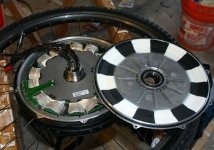liveforphysics
100 TW
I'm making a pair of E-bike for my parents as Christmas gifts.
Methy shipped me a couple 9C hubs. I took a look inside, and I liked everything I saw, except the phase leads. They were not too far off of the hall sensor wire size. lol
I decided 10awg would be a much better suited wire size for the amount of current the motor can be getting.
But, 3x 10awg wires doesn't come close to fitting down the axle, even 2 doesn't fit with the hall sensor wires. So, I stripped off the bulky insulation on the 10awg wires, and slipped over some heat-shrink. This is the same heatshrink used on outrunner motor leads, and it's pretty darn good stuff. You can see how much more thin the wire becomes once it's got shrink wrap for insulation.

I was able to stuff them all through. It took some effort, but I got all 3 pieces of 10awg through with the hall wires.

Two soldered up, one to go.

Cover back in place, and you can see the size difference between the new leads vs the factor wire phase lead I'm holding in my hand in the picture.

Here are more detailed pics of this phase wire upgrade:
"The helpful 9C wire upgrade thread, explicit DIY pictures" (liveforphysics, 3 pages)
https://endless-sphere.com/forums/viewtopic.php?f=2&t=24547
[moderator edit to add link at the bottom]
Methy shipped me a couple 9C hubs. I took a look inside, and I liked everything I saw, except the phase leads. They were not too far off of the hall sensor wire size. lol
I decided 10awg would be a much better suited wire size for the amount of current the motor can be getting.
But, 3x 10awg wires doesn't come close to fitting down the axle, even 2 doesn't fit with the hall sensor wires. So, I stripped off the bulky insulation on the 10awg wires, and slipped over some heat-shrink. This is the same heatshrink used on outrunner motor leads, and it's pretty darn good stuff. You can see how much more thin the wire becomes once it's got shrink wrap for insulation.

I was able to stuff them all through. It took some effort, but I got all 3 pieces of 10awg through with the hall wires.

Two soldered up, one to go.

Cover back in place, and you can see the size difference between the new leads vs the factor wire phase lead I'm holding in my hand in the picture.

Here are more detailed pics of this phase wire upgrade:
"The helpful 9C wire upgrade thread, explicit DIY pictures" (liveforphysics, 3 pages)
https://endless-sphere.com/forums/viewtopic.php?f=2&t=24547
[moderator edit to add link at the bottom]


